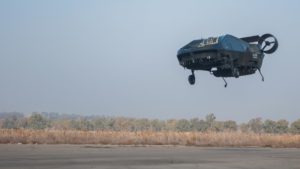 “Attention: all personnel; incoming wounded; choppers in the compound …”
“Attention: all personnel; incoming wounded; choppers in the compound …”
Those nine words have been etched into the collective mind of America’s TV culture as the defining call-to-arms for the iconic dramedy M*A*S*H. However, real-life military hospitals of the future may someday hear a similar call: “Attention: all personnel; incoming wounded; drones in the compound.” Israeli security firm Tactical Robotics Ltd recently announced the first autonomous, untethered flight of the AirMule, an unmanned VTOL drone designed to evacuate injured personnel from the battlefield.
The one-ton model features shrouded rear propellers for horizontal thrust and includes rubberized landing wheels with a forward-facing, boxlike compartment for wounded. Powered by a single 730-shp (shaft horsepower) Turbomeca Arriel 1D1 turboshaft engine, the AirMule boasts a top speed of 120 knots (140 mph, 190 km/h) and can reach an altitude of 12,000 feet (3,600 m). The drone can be operated via remote control or programmed for an autonomous route.
Tactical Robotics had planned to demonstrate the autonomous air-ambulance earlier in 2015 but a “ground incident” damaged the AirMule prototype. The company’s Dec. 30 test flight at the Megiddo airfield in northern Israel took place after approval from the CAA (the Israeli equivalent of the FAA).
“We were … able to set up a portable testing facility with full-time access to a small airfield,” a company official said. “The testing schedule in Megiddo includes plans for a demonstration of AirMule’s cargo delivery capability as well as a ‘beyond the line of sight’ flight along a path running through an adjacent, forested area. All in all, we expect that in 2016 we will finally be able to demonstrate some of AirMule’s unique capabilities.”
Tactical Robotics has designed the AirMule to be stealthy on the battlefield due to its “maneuverability, small visual footprint, low noise and reduced radar and [infrared] signatures.”
Autonomous and unmanned medical UAVs once again demonstrate the idea of “Drones for Good”. In 2014, Alec Momont of the Delft University of Technology in Delft, Netherlands designed an unmanned, autonomous navigating mini-plane that can quickly deliver a defibrillator on the spot where it is needed. According to Momont, a network of such drones could increase the chance of survival after cardiac arrest from 8 percent to 80 percent.
Jason is a longstanding contributor to DroneLife with an avid interest in all things tech. He focuses on anti-drone technologies and the public safety sector; police, fire, and search and rescue.
Beginning his career as a journalist in 1996, Jason has since written and edited thousands of engaging news articles, blog posts, press releases and online content.
Email Jason
TWITTER:@JasonPReagan
Subscribe to DroneLife here.







fezhyek